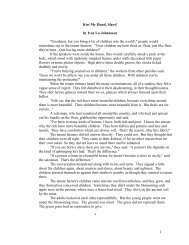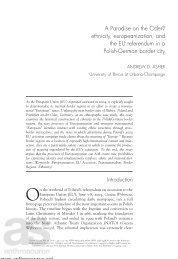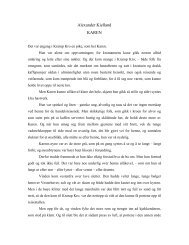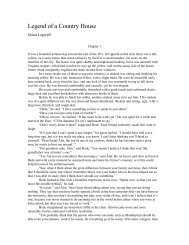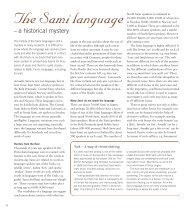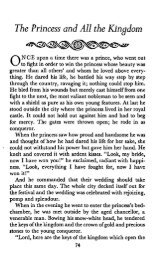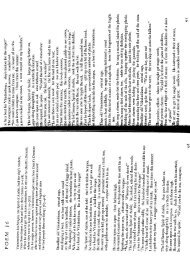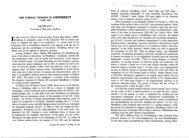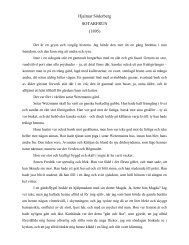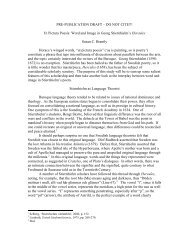Six Views of “The Little Mermaid” - Department of Scandinavian ...
Six Views of “The Little Mermaid” - Department of Scandinavian ...
Six Views of “The Little Mermaid” - Department of Scandinavian ...
Create successful ePaper yourself
Turn your PDF publications into a flip-book with our unique Google optimized e-Paper software.
160 SCANDINAVIAN STUDIES SPLASH! 161<br />
such connotations as the “unhappy,” “longing,” and “pitiable”: “de tznkte<br />
vist ikke paa, at en deilig lille Havfrue stod nedenfor og rakte sine hvide<br />
Hznder op imod Kjalen” (89); “DU stakkels lille Havfrue” [lo61 (certainly<br />
they did not imagine that a lovely little mermaid stood down below and<br />
stretched her white hands up toward the keel; You poor little mermaid).<br />
The melancholic mood is established, too, by the narrator’s way <strong>of</strong><br />
argumentation. Quite <strong>of</strong>ten, through very slight suggestions, he shifts from<br />
rational logic to masochistic or passive lo ic. In the following lines, the<br />
narrator makes the protagonist a passive s s ferer: “men ud ti1 hende smilte<br />
han ikke, han vidste jo ikke heller, at hun havde reddet ham” [94] (but<br />
toward her he did not smile; <strong>of</strong> coufse, neither did he know that she had<br />
saved him). A rational argument would place the responsibility on the<br />
Mermaid herself: he did not smile at her because she had hidden herself and<br />
told him nothing concerning his salvation. Here is another example:<br />
“Prindsen spurge, hvem hun var, og hvorledes hun var kommet her, og<br />
hun saae mildt og dog saa bedrmet paa ham med sine markeblaae 0ine, tale<br />
kunde hun jo ikke” [lo0 f.] (The Prince asked who she was and how she<br />
had come here, and she looked at him so mildly and yet so sorrowfully<br />
with her dark-blue eyes, [for] she could not, <strong>of</strong> course, speak). The rational,<br />
unsentimental comment would be that since she could not speak and did<br />
not try to express herself by gestures or mimicry, he never knew her story.<br />
The optimistic setting <strong>of</strong> the very same conditions could be that although<br />
she could not speak, her sparkling eyes, her expressive dance, and her<br />
gesticulating arms told him more than words could about herself and her<br />
love. A melancholy, sentimental mood is dominant. It is suspended only in<br />
the section in which the Prince refuses the love <strong>of</strong> the Mermaid. In these<br />
lines narrator and narratee suddenly identify with the Prince: “ved hver<br />
Bevzgelse blev hendes Deilighed endnu mere synlig, og hendes Oine talte<br />
dybere ti1 Hjertet, end Slavindernes Sang” [101; italics added] (with each<br />
movement her loveliness became even more apparent, and to the heart her<br />
eyes spoke more deeply than the song <strong>of</strong> slave women). But apart from this<br />
very slight turn in the narrative point <strong>of</strong> view the narrator in the lines <strong>of</strong><br />
rejection is rather withdrawn. What happens on the scale <strong>of</strong> communication<br />
in the following sentences <strong>of</strong> denial?<br />
Prindsen sagde, at bun skulde alledw vme hos ham, og bun fik Lou at<br />
sove udenfor bans Dnr pau en Flniels Pude. (101)<br />
‘yo, du w mig kjmest,JJ sagde Prindsen, ‘t . . du ligner en ung Pige, jeg<br />
engmg sm. ’’ (102)<br />
Dag for Dag bla, bun Prindsen kjmere, ban holdt afhende, som man kun<br />
holde af et godt, kjm Barn, men at gi07-e hende ti1 sin Donning, fddt<br />
ham slet ikke ind. (102)<br />
(The Prince said that she would always be with him, and she had<br />
permission to sleep outside his door on a velvet pillow.<br />
“Of course you are most dear to me,” said the Prince, “you resemble<br />
a young girl I once saw.”<br />
Day by day she became dearer to the Prince; he cared for her as one<br />
can care about a ood, dear child, but to make her his queen never even<br />
occurred to him!<br />
These examples use the arguments <strong>of</strong> psychological sadism, the two <strong>of</strong> them<br />
with no comments. The logic <strong>of</strong> sadism is broken only if the narrator<br />
reckons on a grown-up narratee who is able to discern it. To a child this<br />
cruel logic would properly not be discovered. If this is so, these lines (and<br />
example three explicitly) hurt not only the Mermaid, but the childlike<br />
narratee, who is rejected just as is the childlike in the Mermaid (“som man<br />
kan holde af et godt, kjzrt Barn, men . . .”). These lines reveal an aggressive<br />
attitude toward the Mermaid and the child narratee on the part <strong>of</strong> the<br />
Prince and the narrator. Warring forces between a sadistic rejection <strong>of</strong>, and<br />
a sentimental identification with, the protagonist imbue the narrative<br />
scheme.<br />
Complexity <strong>of</strong> Rhetoric<br />
On the level <strong>of</strong> rhetoric <strong>“The</strong> <strong>Little</strong> <strong>Mermaid”</strong> is very complex. In this<br />
article I can only touch on the main rhetoric figure, the simile. The simile<br />
<strong>of</strong> <strong>“The</strong> <strong>Little</strong> <strong>Mermaid”</strong> at the microlevel is a question <strong>of</strong> style. The simile<br />
is simply the dominating figure, which is quite evident from the first lines<br />
<strong>of</strong> the story:<br />
Langt ude i Havet er Vandet sau blaut, som Bladene pau den deiligste<br />
Kornblomst og sau klart, som det reneste Glas, men det er meget dybt,<br />
dybere end noget Ankertoug naaw, mange Kirketaarne matte stilles<br />
oven au hinundenJ for at mkke fia Bunden op over Vandet. (88;<br />
emp R asis added)<br />
(Far out in the ocean the water is as blue as the petals <strong>of</strong> the loveliest<br />
cornflower and as clear as the purest glass, but it is very deep, deeper than<br />
any anchor line reaches; many church towers would have to be placed on<br />
top <strong>of</strong> one another to reach from the bottom up above the water.)<br />
The simile is a way <strong>of</strong> “thinking” for the protagonist and the Prince;<br />
their concept <strong>of</strong> compatibility is based on the principle <strong>of</strong> similarity:<br />
‘‘rosenrnde Blomster, som lignede Solen der hait oppe” (88); “han lignede<br />
Marmorstatten nede i hendes lille Have” (93); “ ‘Jo, du er mig kjzrest,’<br />
sagde Prindsen ‘. . . du ligner en ung Pige jeg engang saae’ ” [lo21 (rosy red



